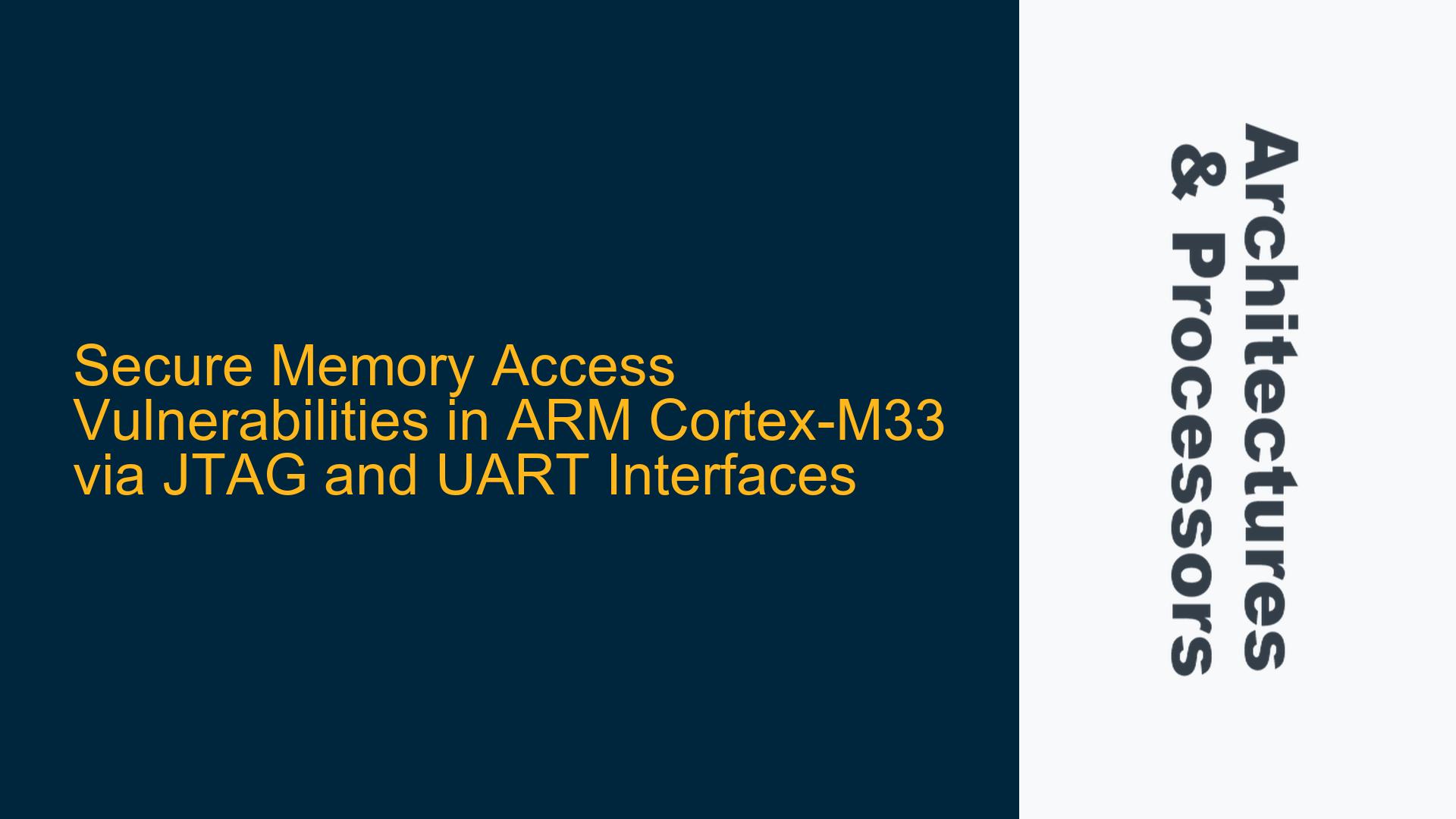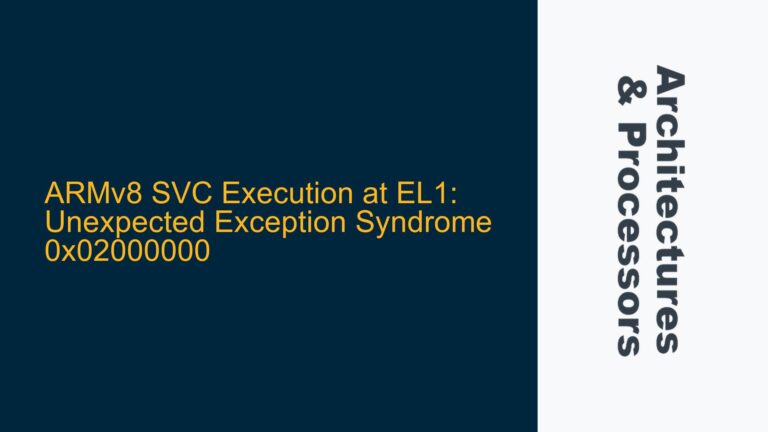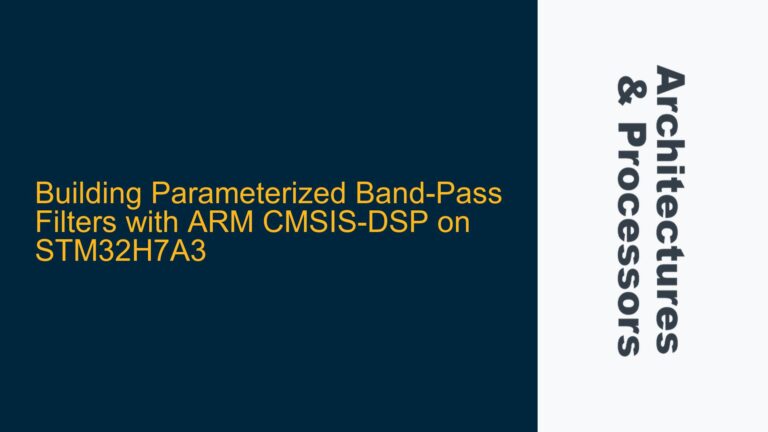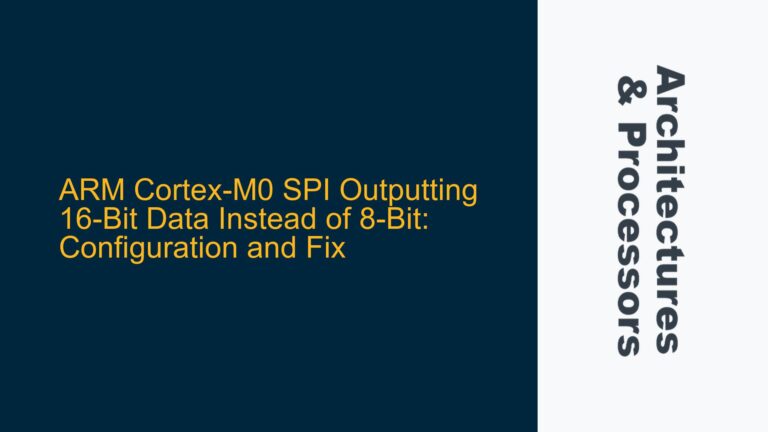ARM Cortex-M33 Secure Memory Exposure via JTAG and UART
The ARM Cortex-M33 processor, with its TrustZone technology, is designed to provide robust security features for embedded systems. However, the security of the system can be compromised if the debug authentication controls are not properly configured or if the software implementation is flawed. Specifically, the JTAG and UART interfaces can become potential vectors for attackers to gain unauthorized access to secure memory regions. This issue is particularly critical in systems where sensitive data is stored in secure memory, and any breach could lead to significant security vulnerabilities.
The JTAG interface, commonly used for debugging and programming microcontrollers, can be exploited if the debug authentication mechanisms are not correctly set up. Similarly, the UART interface, often used for communication with external devices, can be a weak point if the software handling the UART data does not properly secure the memory buffers used for storing received data. The combination of these factors can lead to scenarios where an attacker could potentially access secure memory, execute unauthorized code, or inject malicious code into the system.
Debug Authentication Misconfiguration and UART Software Vulnerabilities
The primary cause of secure memory exposure in the ARM Cortex-M33 is the misconfiguration of debug authentication controls. The Cortex-M33 provides several mechanisms to secure the debug interface, including the ability to lock down the JTAG and Serial Wire Debug (SWD) interfaces. However, if these controls are not properly configured, an attacker could use the JTAG interface to bypass security measures and gain access to secure memory. This is particularly concerning in systems where the debug interface is left enabled in production, either intentionally or accidentally.
Another significant cause of secure memory exposure is the improper handling of UART data in the software. When data is received via UART, it is typically stored in a buffer in memory. If this buffer is located in secure memory and the software does not properly validate or sanitize the incoming data, it could lead to vulnerabilities such as buffer overflows or code injection attacks. Additionally, if the memory region used for the UART buffer is not marked as eXecute Never (XN) using the Secure Memory Protection Unit (MPU), an attacker could potentially inject and execute malicious code.
The combination of these factors creates a scenario where an attacker could exploit the JTAG interface to bypass security measures and then use the UART interface to inject malicious code or access secure memory. This is particularly concerning in systems where the UART interface is used for communication with untrusted external devices, as it increases the attack surface and the potential for security breaches.
Implementing Secure Debug Authentication and UART Data Handling Best Practices
To mitigate the risks associated with secure memory exposure in the ARM Cortex-M33, it is essential to implement secure debug authentication and follow best practices for UART data handling. The following steps outline the necessary measures to secure the system:
Secure Debug Authentication Configuration
-
Enable Debug Authentication Controls: Ensure that the debug authentication controls are properly configured to lock down the JTAG and SWD interfaces. This includes setting the appropriate fuse bits or configuration registers to disable debug access in production devices. The Cortex-M33 provides several options for securing the debug interface, including the ability to require a debug authentication key before allowing access to the debug interface.
-
Use Secure Debug Channels: Implement the use of secure debug channels such as the Arm SDC-600. The SDC-600 provides a secure communication channel between the debugger and the target device, ensuring that only authorized debuggers can access the system. This adds an additional layer of security by encrypting the debug communication and requiring authentication before allowing access.
-
Disable Debug Interface in Production: Ensure that the debug interface is disabled in production devices. This can be done by setting the appropriate configuration bits or fuses to permanently disable the JTAG and SWD interfaces. This prevents attackers from using the debug interface to gain access to the system.
UART Data Handling Best Practices
-
Secure UART Buffer Memory: Ensure that the memory region used for the UART receive buffer is located in secure memory and is properly protected using the Secure MPU. Set the memory region as eXecute Never (XN) to prevent code injection attacks. This ensures that even if an attacker manages to inject malicious code into the buffer, it cannot be executed.
-
Validate and Sanitize UART Data: Implement robust validation and sanitization of incoming UART data. This includes checking for buffer overflows, ensuring that the data is within expected bounds, and sanitizing any potentially malicious input. This reduces the risk of buffer overflow attacks and code injection.
-
Use Secure Communication Protocols: Implement secure communication protocols for UART communication, such as encryption and authentication. This ensures that the data transmitted over the UART interface is protected from eavesdropping and tampering. Additionally, use secure boot and firmware update mechanisms to ensure that only authorized firmware can be loaded onto the device.
-
Monitor and Log UART Activity: Implement monitoring and logging of UART activity to detect any suspicious behavior. This includes logging incoming and outgoing data, as well as monitoring for any unusual patterns or anomalies. This can help in identifying potential attacks and taking corrective action before any damage is done.
Additional Security Measures
-
Implement Secure Boot: Ensure that the system implements secure boot to verify the integrity and authenticity of the firmware before execution. This prevents unauthorized or malicious firmware from being loaded onto the device.
-
Use Hardware Security Modules (HSMs): Consider using Hardware Security Modules (HSMs) to provide additional security for sensitive operations. HSMs can be used to securely store cryptographic keys, perform secure boot, and provide a secure execution environment for critical operations.
-
Regular Security Audits: Conduct regular security audits and penetration testing to identify and address any potential vulnerabilities in the system. This includes reviewing the configuration of debug authentication controls, UART data handling, and overall system security.
By following these steps, you can significantly reduce the risk of secure memory exposure in the ARM Cortex-M33 and ensure that the system remains secure against potential attacks via the JTAG and UART interfaces. It is essential to adopt a proactive approach to security, regularly reviewing and updating the security measures to address any new threats or vulnerabilities that may arise.
Summary of Key Security Measures
| Security Measure | Description |
|---|---|
| Enable Debug Authentication Controls | Configure debug authentication to lock down JTAG and SWD interfaces. |
| Use Secure Debug Channels | Implement Arm SDC-600 for secure debug communication. |
| Disable Debug Interface in Production | Permanently disable JTAG and SWD interfaces in production devices. |
| Secure UART Buffer Memory | Use Secure MPU to set UART buffer memory as eXecute Never (XN). |
| Validate and Sanitize UART Data | Implement robust validation and sanitization of incoming UART data. |
| Use Secure Communication Protocols | Implement encryption and authentication for UART communication. |
| Monitor and Log UART Activity | Log and monitor UART activity for suspicious behavior. |
| Implement Secure Boot | Verify firmware integrity and authenticity before execution. |
| Use Hardware Security Modules (HSMs) | Provide additional security for sensitive operations. |
| Regular Security Audits | Conduct regular security audits and penetration testing. |
By implementing these security measures, you can ensure that the ARM Cortex-M33 system remains secure against potential attacks via the JTAG and UART interfaces, protecting sensitive data and maintaining the integrity of the system.






